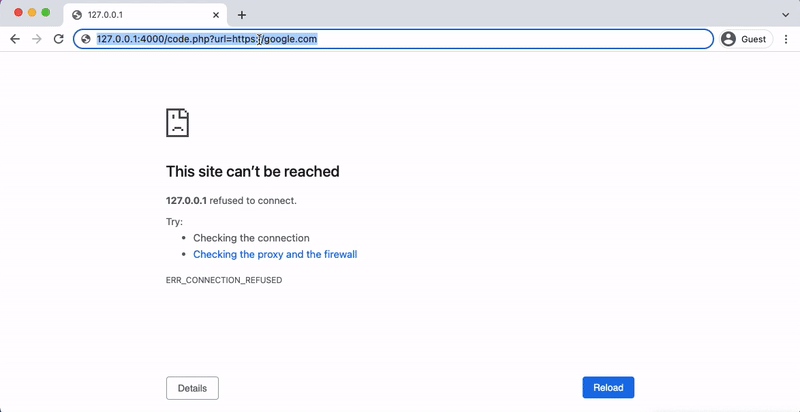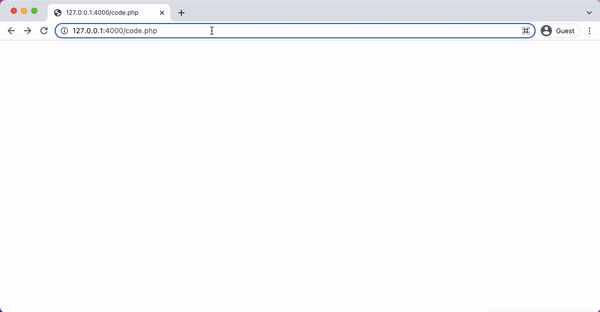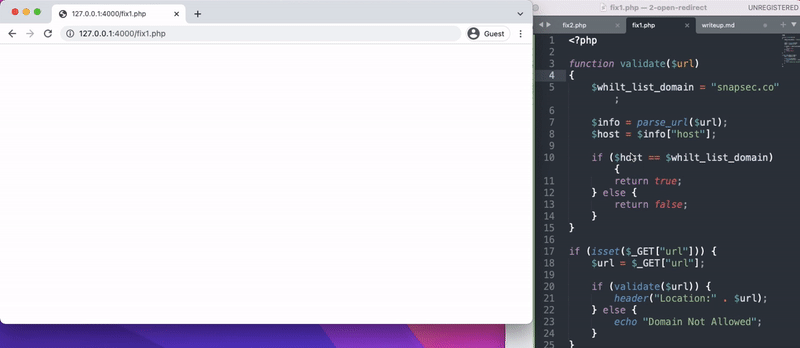Security Simplified - Open Redirect [Server Side]
![Security Simplified - Open Redirect [Server Side]](/blog/assets/images/SecuritySimplified/or-2/0.png)
Open redirection vulnerabilities arise when an application incorporates user-controllable data into the target of a redirection in an unsafe way. An attacker can construct a URL within the application that causes a redirection to an arbitrary external domain. -portswigger
Please note that open redirection can be caused by the code sitting at the server side as well as code at the front-end. In this blog article, we will examine server-side perspective.
Vulnerable Code Snippet (Server Side)
1
2
3
4
5
6
<?php
if(isset($_GET['url'])){
$url=$_GET['url'];
header('Location:'.$url);
}
?>
In the Above Code Snippet:
-
isset() is a function which checks whether a variable is empty or not and if the variable is set/declared. If the variable is not empty it returns True otherwise false.
-
$_GETis a PHP super global variable which is used to access GET based parameters from anywhere in the PHP script, As an example, if you visit a URLhttps://snapsec.co/book.php?id=1. The following code allows the book.php to access the URL’s GET-basedidparameter.$_GET['id'].
The echo "" statement is used to print any values passed within the quotes. This data is written in a response sent to the user.
-
The header() function sends a raw HTTP header to a HTTP client which is browser in this case.
-
The HTTP Location header is a response header indicates the URL to redirect a user to.
Conclusion:
So, from this code snippet, we can derive that it checks if the GET based parameter ‘url’ is set in the URL, and if it is, it sends a raw HTTP Response Header ‘Location’ set to the client with a value set to whatever is sent in the client’s request.
In other words, it redirects the user to the value he/she specified in the url parameter.
Exploitation
If the website does not validate the url parameters, we can simply enter any web address in the url parameter and it will redirect us to the page.

Where is the problem
Now the question is which part of the code snippet is vulnerable and what makes it vulnerable?
The vulnerability in this case is rather straightforward: the current code snippet adds the value of the ‘url’ parameter to the response header that is transmitted to the client without any input constraints. Therefore header('Location:'.$url); is the actual piece of code that causes this vulnerability.
Fix
The solution can change depending on the circumstance. One solution is to allow only whitelisted domains or relative urls to be redirected to.
While Listed Domains
1
2
3
4
5
6
7
8
9
10
11
12
13
14
15
16
17
18
19
20
21
22
23
24
25
26
27
28
29
30
<?php
function validate($url)
{
$whilt_list_domain = "snapsec.co";
$info = parse_url($url);
$host = $info["host"];
if ($host == $whilt_list_domain) {
return true;
} else {
return false;
}
}
if (isset($_GET["url"])) {
$url = $_GET["url"];
if (validate($url)) {
header("Location:" . $url);
} else {
echo "Domain Not Allowed";
}
}
?>

In the following php code, we introduce a new function called Validate(url), This function takes a user input URL as parameter and then checks if the host of the URL is equal to the white-listed domain. If that is the case, it allows redirection to happen; otherwise, the redirection is blocked and an error message Domain Not Allowed is blocked.
Allowing Only Absolute URL’s
One of the interesting fixes would be only allowing relative URL’s, which would block all open redirection attempts.
1
2
3
4
5
6
7
8
9
10
11
12
13
14
15
16
17
18
19
20
21
22
<?php
function validate($url)
{
$pattern = "/^(?:\/|\\|\w\:\\|\w\:\/).*$/";
return preg_match($pattern, $url);
}
if (isset($_GET["url"])) {
$url = $_GET["url"];
if (validate($url)) {
header("Location:" . $url);
} else {
echo "Absulute URL's Not Allowed";
}
}
?>
The function Validate(url) is introduced in the following PHP code. It accepts a user-inputted url as a parameter and determines whether the value is a relative url by comparing it to a regular expression saved in the pattern variable. Redirecting is permitted if the URL is relative; otherwise, it is prohibited.
Confirming the FIX
- On going back and trying to reproduce open redirection on both the fixes , Yon can see we were able to fix the vulnerabilities.

About us
Snapsec is a team of security experts specialized in providing pentesting and other security services to secure your online assets. We have a specialized testing methodology which ensures indepth testing of your business logic and other latest vulnerabilities.
If you are looking for a team which values your security and ensures that you are fully secure against online security threats, feel free to get in touch with us #support@snapsec.co
 Never miss a story from us, subscribe to our newsletter
Never miss a story from us, subscribe to our newsletter